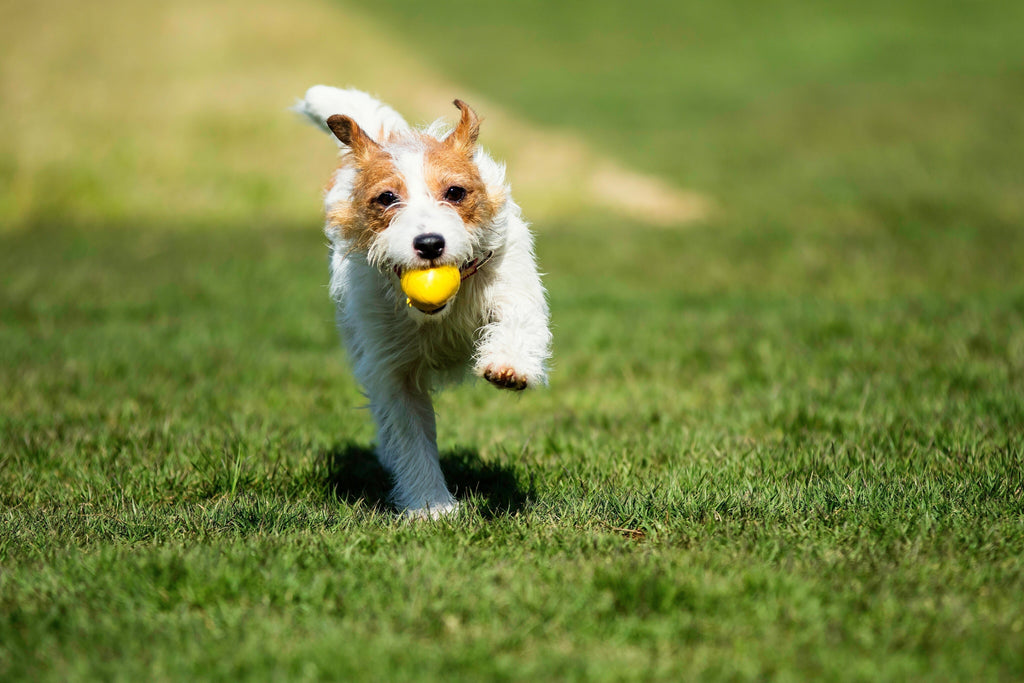Sustainable Dog Food in Australia: 9 Eco-Friendly Practices

Choosing your dog’s food based on the quality of the ingredients as well as their dietary needs is a no-brainer. But what if you want to go above and beyond? Then you will want to select a sustainable dog food made here, in Australia. If you are concerned this will come at a cost to your pets health and nutrition, don’t worry, many of the most sustainable sources of food are higher in protein and even richer in essential nutrients supporting yours dogs wellbeing!
What Is Your Dog’s Carbon Paw Print?
So, what impact does your dog have on the planet? An average size dog is responsible for 770kg of CO2e per year! This is equivalent to driving to Darwin from Melbourne and back, with some detours!
The primary contributor to a dog's carbon footprint is its diet, largely due to the meat content in commercial dog foods. Meat production demands extensive resources like land, water, and energy, leading to deforestation, habitat loss, and greenhouse gas emissions. Additionally, processing, transportation, and packaging of dog food further increase its carbon pawprint!
1. Greenhouse Gases
Meat production is a major contributor of greenhouse gases like methane and nitrous oxide. In fact, meat production for people and pets accounts for 87% of greenhouse gases each year. These gases get trapped in the atmosphere, trapping heat, and raising the Earth’s temperature.
Which meat is the worst offender? Beef. Cows produce a lot of methane due to their grass-rich diet–and that grass-rich diet requires healthy crops, which require nitrous oxide fertilisers. The combination is a lot of excess chemicals.
What is a better alternative? We love Kangaroo as a sustainable, high protein source of meat. As a comparison, on average, 244 grams of Kangaroo meat can be produced per kilogram of greenhouse gas emissions compared to only 44 grams of beef per kilogram of emissions from cattle.
Of course, if you are looking to take it even a step further to protect our planet, consider feeding a meat-alternative protein source, such as black soldier flies larvae! Yum!
2. Land Use
Cows need pasture, as do other meat sources such as lamb. Other ingredients that go into dog food also requires vast farmlands. The demand for this land has led to deforestation and depleting the soil of its natural nutrients. Using land to grow crops also creates conditions that can increase soil erosion and the displacement of wildlife.
How can you minimise the land use related to your dog’s diet? Purchase dog food from reputable brands that source ingredients locally and from smaller, family-owned farms.
3. Water Use
A tremendous amount of water is required to raise livestock for dog food. This puts a strain on water resources and can lead to contamination of fresh water sources.
4. Fossil Fuels
Fossil fuels aren’t just used to transport your dog’s food from the manufacturer to a retailer or delivered to your home. They are also used at various points of the process of raising, making, and packaging your dog’s food.
What to Look for When Comparing Sustainable Dog Food Brands
Finding the most sustainable dog food can be tricky. In the world of greenwashing, many companies use the guise of greenness to convince pet parents to choose their products. So, to ensure you’re supporting a sustainable world by buying eco-friendly dog food, look for these commitments:
#1 Sustainable Dog Food Companies Make Their Food in Australia
The first step to protecting our incredible country in Australia is to look at where your dog food is made. Not all countries control the things that go into dog food, nor do they all handle the ingredients safely. You need to get your dog’s food from a country that inspects and monitors the things that go into the food as well as the way that they are handled.
In addition, the closer the food is made to the consumer, the smaller the transportation carbon footprint. This also means that the food gets to you soon and fresher so your doggo gets the best tasting and highest quality meals.
#2 Check to See If They Source Ingredients Locally
Local ingredients are better. In fact, did you know, Australian fruits and vegetables are often higher in nutrients due to the high-quality soil, climate, and high regulatory standards.
Not only will the ingredients be fresher, they will also retain more essential nutrients that are often lost during long transport times, resulting in a lower carbon footprint due to being shipped shorter distances! Choose Aussie made dog food for the best quality and sustainability, giving your furry pal the nutrients they deserve!
#3 Eco-Friendly Dog Foods Use Farmers Who Follow Sustainable Practices

Sadly, not all farmers use sustainable practices. According to the Union of Concerned Scientists, sustainable farming includes:
- Building healthy soil and preventing erosion
- Managing water wisely
- Minimising air and water pollution
- Storing carbon on farms
- Increasing resilience to extreme weather
- Promoting biodiversity [2]
When a company uses responsibly sourced fruits, grains, and veggies, it is better for your dog and much better for the long-term health of the planet.
#4 Check to See If They Use Low-Impact Meats
As we have mentioned, meat can really increase the carbon footprint of dog food, but not all meat is “sourced” equally. Look at the type of meat and the way the animals are raised and fed.
Wild-Caught Kangaroo
Kangaroo is a great meat for your dog. Because it is wild, it is low in fat and full of micronutrients. They forage so there is no carbon footprint for their feed. The government regulates the way that kangaroos are harvested. “The national code of practice for the humane shooting of kangaroos and wallabies mandates kangaroos must be shot in the head, and bans shooting from vehicles or selecting a second target before the first is dead.” [3] And there is a limit of 20% of the population that can be used. [3] So it keeps the population at a healthy level. And kangaroos do less damage to the land than sheep or cattle.
#7 Participate in a Tree-Planting Program
One of the best ways to offset carbon is by planting a tree. There are a number of programs run by reputable organisations that will plant trees to help individuals and companies to offset their carbon dioxide. Not only does it sink carbon dioxide but it helps protect and build soil and provide shade as well as purify the air.
Petzyo is proud to partner with Greenspark, who helps us achieve our mission to plant a tree for every order made! Want to know just how many trees we have planted thanks to your support - head to our Impacts page to find out more!
#8 Use Sustainable Packaging
How much material and what type of materials does a company use to package their goods? Packaging should be reduced as much as possible, and it should also be made of materials that are sustainable and recyclable. Some boxes and wrapping paper are made of recycled material. Consumer should then recycle as much of the packaging once the goods have arrived.
#9 Work-from-Home Employee Options
The environment isn’t the only thing that responsible companies need to do–they also need to offer their employees the option to work at home. While not all jobs can be done remotely, many can. Working from home reduces commuting emissions, conserves energy, and promotes resource conservation. By eliminating the need for office spaces, it lowers electricity usage and diminishes reliance on fossil fuels. Studies have shown that by working from home it may reduce a person's carbon footprint by more than 50 percent! Overall, remote work offers sustainability benefits by fostering a greener approach to work and lifestyle.
Choosing the Most Eco-Friendly Dog Food
The pet food industry offers a wide range of options for your dog–many of which are eco-friendly. We are proud to provide pet owners with healthy dog food that are eco-friendly. If you’re looking for a food for your dog that minimises their impact on the Earth, use this checklist:
- Sustainable ingredients: Producers use an eco-friendly approach to farming practices
- Australian-grown ingredients: Reduce the fossil fuels for shipping
- A carbon-offset program: While no dog food is completely zero-impact, environmentally responsible companies will offset their impact.
- A partnership with a environmental nonprofit: It’s always a great sign if the company you’re buying from is partnered with a nonprofit organisation. It shows the company cares about our future and wants to give back!
Petzyo: The Best Sustainable Dog Food in Australia

If you are looking for a sustainable dog food brand, Petzy could be the brand for you!
- Locally sourced ingredients
- Sustainably sourced ingredients
- Recycled Packaging
- Planting Trees for every order made
- Partnered with Greenspark
- Lower carbon emission alternative protein sources such as Kangaroo and Poultry
- A very happy team of work from home employees!!
Resources
[1] Sustainability and Pet Food
[2] What Is Sustainable Agriculture?
[3] Australia's Kangaroo Meat Trade Could Be the Most Sustainable in the World, Despite Welfare Concerns
[4] A Game Changer for Our Carbon Footprint and Sustainable Eating




